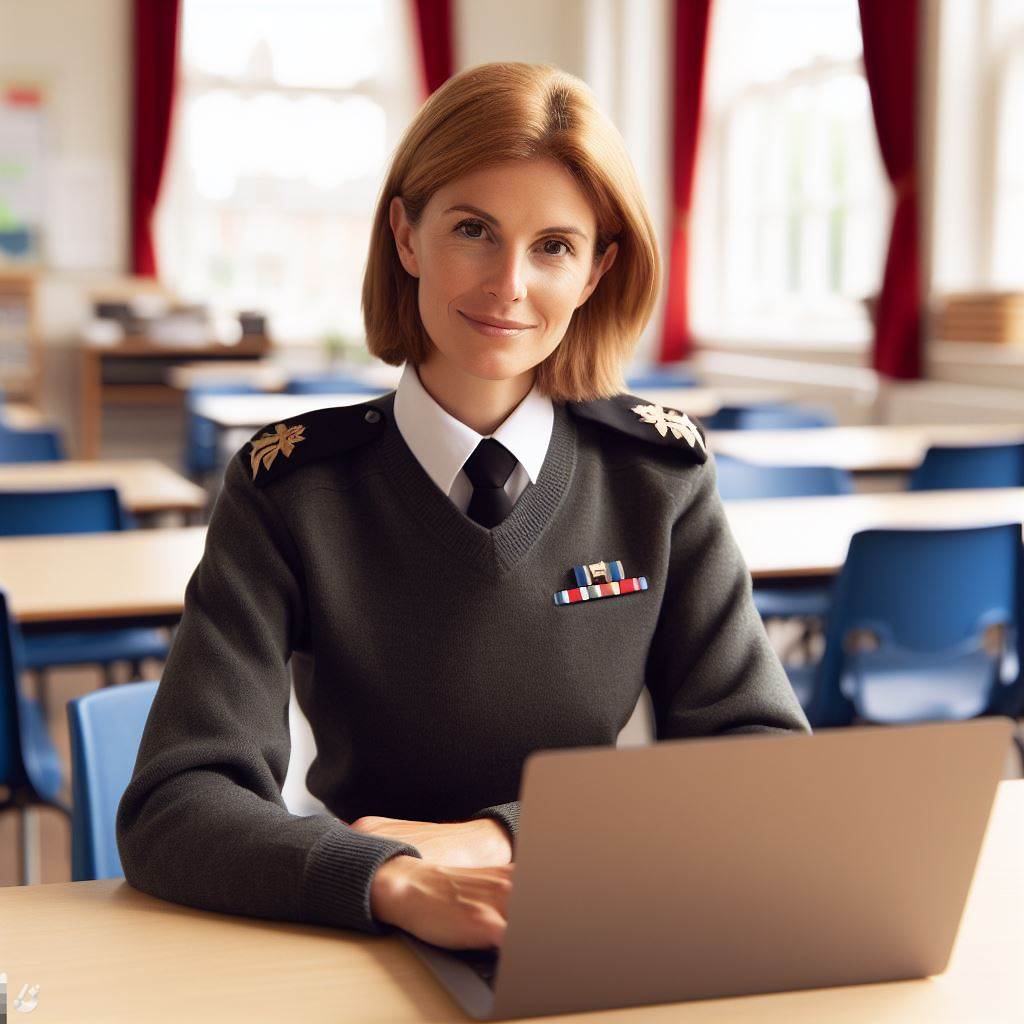Introduction
A. Importance of balancing technology and personal interaction in educational advice
In today’s technology-driven world, it is crucial to strike a balance between using technology and personal interaction in educational advice.
B. Overview of how technology has impacted the education sector
The impact of technology on the education sector cannot be denied. It has revolutionized teaching methods, providing students with access to vast amounts of information and resources.
However, relying solely on technology can lead to a lack of human connection and personal touch.
Technology has transformed classrooms, making them more interactive and engaging. Students can now collaborate with peers from across the globe, access online learning platforms, and receive instant feedback.
While these advancements undoubtedly enhance the learning experience, they should not overshadow the importance of human interaction.
C. Thesis statement
A harmonious integration of technology and human touch is crucial in educational advice.
Despite the vast potential of technology, students still need that personal touch, a guiding hand, and emotional support from their teachers and mentors.
This human element helps build trust, rapport, and motivation, which are essential for effective learning.
When providing educational advice, it is vital to combine the benefits of technology with the warmth of personal interaction.
Technology can offer personalized learning experiences, but it cannot replace the empathy, understanding, and emotional connection that human interaction provides.
A skilled advisor knows how to effectively utilize technology while maintaining genuine human engagement.
In general, while technology has revolutionized education, it is crucial to maintain a balance between technology and personal interaction in educational advice.
By harmoniously integrating both, we can create an enriching learning environment that combines the best of both worlds, ultimately benefiting students in their educational journey.
The Role of Technology in Education
A. Revolutionizing Access to Information and Resources
In the realm of education, technology acts as a catalyst, transforming the way we access information and resources.
With the advent of digital tools, students now enjoy unprecedented access to a vast sea of knowledge.
- Global Reach: Technology has obliterated geographical barriers, connecting learners to a global pool of information.
- Online Libraries: Digital libraries provide a virtual haven of resources, empowering students to delve into diverse subjects.
- Instant Updates: Real-time updates ensure that educational content remains current, aligning with the dynamic nature of knowledge.
B. Technological Tools in Educational Settings
The classroom landscape has evolved, embracing tools that transcend traditional teaching methods.
Smart boards, online learning platforms, and educational apps are now integral components of modern education.
- Smart Boards: Interactive whiteboards facilitate dynamic lessons, enhancing student engagement and understanding.
- Online Learning Platforms: Platforms like Khan Academy and Coursera offer a plethora of courses, fostering self-paced learning.
- Educational Apps: From language learning to interactive science simulations, apps cater to diverse learning styles.
C. Benefits of Technology in Personalized Learning and Engagement
The true power of technology in education lies in its ability to tailor learning experiences, catering to individual needs and fostering engagement.
- Personalized Learning Paths: Adaptive algorithms analyze student performance, creating customized learning paths for optimal comprehension.
- Enhanced Engagement: Gamified elements in educational apps transform learning into an interactive adventure, capturing and sustaining student interest.
- Feedback Loops: Instant feedback loops empower students to track their progress, fostering a sense of accomplishment and motivation.
In a nutshell, the infusion of technology in education is not merely a trend but a revolutionary force.
It democratizes knowledge, transforms classrooms, and personalizes learning experiences.
Embracing this tech-touch balance ensures that education remains not only informative but also engaging and accessible to all.
Limitations of Technology in Education
When it comes to integrating technology in education, there are certain limitations that need to be addressed.
While technology offers numerous benefits, it is essential to acknowledge the concerns surrounding its over-reliance in educational advice.
Personalized UK Career Consulting
Receive tailored career guidance designed just for you. Get actionable steps and expert support to boost your career in 1-3 days. Take control of your career now.
Get StartedA. Addressing the concerns surrounding over-reliance on technology in educational advice
- Technology should be viewed as a tool rather than a replacement for traditional teaching methods.
- Over-reliance on technology can lead to a lack of critical thinking and problem-solving skills in students.
- Teachers should guide students on how to use technology effectively and responsibly.
B. Lack of personalization and individual attention in technology-based learning
- Technology-based learning often lacks the personal touch that face-to-face interactions provide.
- Individual student needs may not be adequately addressed in a technology-driven classroom.
- Teachers should supplement technology with personalized instruction to cater to diverse learning styles and abilities.
C. Potential negative impact on students’ social and emotional development
- Excessive screen time and isolation in technology-based learning can hinder social interactions.
- Students may struggle with building interpersonal skills and forming meaningful relationships.
- Teachers should encourage collaborative activities and create opportunities for students to interact offline.
While technology offers immense potential, it is crucial to recognize its limitations and take necessary precautions.
By acknowledging these limitations, educators can strike a balance between technology and personal touch, ensuring holistic development for students.
Read: The Role of a Teacher in UK Society
The Importance of Human Touch in Educational Advice
A. Emphasizing Personal Connection and Emotional Support in Education
In the realm of education, technology has surged forward, but the human touch remains irreplaceable. Why? Because…
- Emotional Bonding: Students thrive on emotional connections. In-person interactions forge bonds that digital platforms struggle to replicate.
- Empathy Matters: Beyond algorithms, human advisors read emotions, sensing stress, and adapting guidance accordingly.
- Real-Time Feedback: Face-to-face conversations allow immediate response, creating a dynamic exchange essential for effective educational support.
B. Ability of Human Interaction to Provide Customized Guidance and Motivation
- Tailored Advice: Personalized learning requires personalized advice. Human mentors adapt guidance to each student’s unique learning style and needs.
- Motivational Impact: A computer lacks the warmth of a pat on the back or a reassuring smile, crucial for motivation.
- Nuanced Understanding: Human advisors comprehend subtleties, understanding the ‘why’ behind a struggle, enabling targeted assistance.
C. Building Trust and Rapport Through Face-to-Face Interactions
- Trust Building: Trust is built through eye contact, body language, and the assurance of a human presence—a foundation for effective education.
- Rapport Development: Face-to-face interactions foster rapport, creating an environment where students feel comfortable sharing challenges and seeking guidance.
- Cultural Sensitivity: Human advisors inherently grasp cultural nuances, ensuring advice aligns with diverse backgrounds and values.
In summary, while technology propels education forward, the essence of human touch remains unparalleled.
Personal connections, tailored guidance, and trust-building are pivotal aspects that only human interaction can deliver.
As we navigate the tech-infused landscape of education, let’s not forget the transformative power of a caring, empathetic, and understanding human touch.
After all, education isn’t just about transferring information; it’s about building futures, and that requires the delicate balance of tech and touch.
Read: Mental Health Support for UK Teachers
Finding the Right Balance
As technology becomes increasingly prevalent in education, finding the right balance between tech and touch is crucial.
Educators and advisors must strive to integrate technology and human touch effectively to create an optimal learning environment.
1. Blended Learning Approach
One strategy is to implement a blended learning approach that combines online resources with personal interactions.
- Utilize online platforms and tools to provide access to educational materials and resources.
- Supplement online learning with in-person discussions, activities, and hands-on experiences.
- By blending technology and human touch, students can benefit from the advantages of both methods.
2. Encouraging Collaboration and Group Discussions
Another effective way to balance tech and touch is by encouraging collaboration and group discussions in both digital and physical spaces.
- Use online collaboration tools to facilitate group work and discussions.
- Create opportunities for students to interact face-to-face, fostering interpersonal skills.
- Both digital and physical interactions provide unique perspectives and enhance learning outcomes.
3. Building Meaningful Relationships
Incorporating human touch in education means building meaningful relationships between educators, advisors, and students.
- Encourage open communication and provide ongoing support to students through personalized interactions.
- Show empathy, understanding, and emotional presence to create a positive learning environment.
- Developing trust and rapport enhances student engagement and overall academic success.
4. Individualized Instruction
Technology can play a significant role in providing individualized instruction while maintaining a personal touch.
- Utilize educational apps and software that adapt to students’ learning needs and abilities.
- Combine personalized feedback with face-to-face interactions to address individual strengths and weaknesses.
- Customized instruction enhances student motivation, comprehension, and achievement.
5. Stay Mindful of Screen Time
While technology offers numerous benefits, it is important to be mindful of screen time and its potential negative effects.
Your Dream Job Starts with a Perfect CV
Get a tailored CV and cover letter that captures your unique strengths and stands out in your industry. Let us help you make an unforgettable first impression.
Get Started- Set limits on technology usage to promote a healthy balance between digital and physical activities.
- Encourage breaks, physical exercise, and hands-on experiences to reduce the negative impact of excessive screen time.
- Prioritize quality screen time that is educational, interactive, and meaningful.
6. Professional Development for Educators
Educators and advisors should continuously seek professional development opportunities to enhance their understanding of technology integration.
- Attend workshops, conferences, and webinars focused on effective technology integration in education.
- Collaborate with colleagues to share best practices and learn from each other’s experiences.
- Stay up-to-date with advancements in educational technology and innovative teaching strategies.
7. Evaluating and Adapting
Regularly evaluate the effectiveness of technology integration and make necessary adaptations to strike the right balance.
- Solicit feedback from students, parents, and colleagues to gauge the impact of technology on the learning experience.
- Analyze data and student performance to identify areas where technology may be overused or underutilized.
- Continuously refine teaching practices and make adjustments to optimize learning outcomes.
Basically, achieving the right balance between tech and touch in education requires intentional efforts from educators and advisors.
Blending learning methods, fostering collaboration, forming connections, tailoring teaching, monitoring screen time, pursuing growth, and adapting strategies drive successful tech-human education fusion.
Read: Continuing Education for UK Teachers

Success Stories and Examples
In this section, we will delve into the success stories and examples of educational institutions and advisors who have effectively balanced technology and human touch in their educational advice.
We will explore the specific tools or methods they have used and highlight the positive outcomes experienced by students and learners.
A. Sharing Success Stories
- An exemplary success story is Oakridge International School, which successfully integrates technology into its curriculum.
- By incorporating virtual classrooms supplemented with personalized mentoring, Oakridge ensures an ideal balance.
- Another success story is from the University of Southern California, where advisory services have been digitized.
- The university uses AI-powered chatbots to provide immediate guidance and support to students.
- These success stories demonstrate that technology can enhance educational advice without losing the human touch.
B. Tools and Methods Used for Effective Educational Advice
- Educational advisors widely use online platforms like Zoom and Google Meet to provide personalized guidance.
- Virtual whiteboards and interactive polls are utilized to maintain student engagement during remote sessions.
- Artificial intelligence tools, such as automated essay graders, assist in efficient and timely feedback.
- Learning management systems like Canvas and Blackboard facilitate seamless communication between students and advisors.
- These tools and methods contribute to the overall efficacy of educational advice in a technological era.
C. Exploring Positive Outcomes
- Students who receive technologically enhanced educational advice report higher levels of engagement and motivation.
- Personalized guidance through technology helps students develop essential skills and achieve academic success.
- The convenience of remote advice allows students to seek help more readily, fostering a supportive learning environment.
- Interactive platforms enable advisors to track students’ progress and identify areas needing additional attention.
- Overall, the positive outcomes of balancing tech and touch in educational advice are evident in student achievements.
These success stories and examples demonstrate how educational institutions and advisors have effectively embraced technology while maintaining the human touch in their educational advice.
By utilizing specific tools and methods, they have achieved positive outcomes for students and learners.
It is crucial to acknowledge that technology can never fully replace the personal connection and individualized support provided by human advisors.
However, when used appropriately, technology empowers educational advisors to reach a wider audience and provide quality guidance.
As we move forward into a digital era, striking the right balance between technology and human touch remains vital for the success of educational advice.
By learning from these success stories and examples, we can ensure that technology enhances educational experiences while preserving the unique insights and encouragement offered by human advisors.
Read: Diversity in UK Teaching: Current Trends
Explore Further: UK Edu Admins & Student Success
Challenges and Future Outlook
When it comes to balancing technology and touch in education advice, there are several challenges that educators and advisors often face.
However, there are also upcoming trends and advancements in educational technology that can help address these challenges.
In addition, it is crucial for educators and advisors to emphasize the importance of adaptability and continuous learning.
A. Challenges Faced in Achieving a Harmonious Balance
- Resistance to Change: One of the major challenges is resistance from educators and advisors themselves, who may be reluctant to adopt new technologies or change their traditional teaching methods.
- Limited Access to Technology: Not all schools or educational institutions have the necessary resources and infrastructure to provide access to advanced technology tools and devices.
- Unequal Learning Opportunities: The digital divide is still prevalent, where students from disadvantaged backgrounds may lack access to technology outside of the classroom.
- Technological Competency: Some educators and advisors may lack the necessary skills and knowledge to effectively integrate technology into their teaching practices.
- Overreliance on Technology: There is a risk of overreliance on technology, where educators may solely depend on digital tools without considering the importance of human connection and engagement.
B. Upcoming Trends and Advancements in Educational Technology
- Virtual and Augmented Reality: These technologies have the potential to revolutionize education by providing immersive learning experiences.
- Artificial Intelligence: AI-powered tools can personalize learning, provide real-time feedback, and assist educators in curriculum design.
- Internet of Things (IoT): IoT devices can enable greater connectivity and collaboration, allowing for seamless integration of technology in the classroom.
- Mobile Learning: With the increasing accessibility of smartphones and tablets, mobile learning apps and platforms are gaining popularity.
- Data Analytics: Utilizing data analytics can help educators track student progress, identify areas for improvement, and make data-driven instructional decisions.
C. The Importance of Adaptability and Continuous Learning
Given the rapid advancements in educational technology, it is crucial for educators and advisors to embrace adaptability and continuously update their skills.
Here’s why:
- Meeting Student Needs: Different students have different learning preferences and needs. By being adaptable, educators can cater to a diverse range of learners.
- Staying Relevant: Technology is ever-evolving, and staying up-to-date with advancements ensures that educators remain relevant in a rapidly changing educational landscape.
- Enhancing Teaching Effectiveness: Continuous learning allows educators to incorporate new pedagogical strategies and tools that enhance their teaching effectiveness.
- Preparing Students for the Future: As educators adapt to new technologies, they can better prepare students for the demands of the digital age and the workforce.
- Fostering Lifelong Learning: By modeling adaptability and continuous learning, educators inspire their students to become lifelong learners themselves.
Ultimately, achieving a harmonious balance between technology and touch in education advice requires addressing challenges such as resistance to change and limited access to technology.
However, with upcoming trends and advancements in educational technology, educators and advisors have the tools to overcome these challenges.
It is essential for educators to embrace adaptability and continuous learning to effectively integrate technology and provide a holistic learning experience for their students.
Optimize Your LinkedIn for Success
Boost your LinkedIn profile with a professional bio, keyword-rich headline, and strategic recommendations that attract recruiters. Stand out from the crowd and get noticed.
Optimize NowConclusion
Finding equilibrium between technology and human interaction in education is pivotal for comprehensive student development.
Throughout this discourse, we’ve unearthed strategies fostering a harmonious blend, ensuring optimal learning outcomes.
The synergy between technological advancements and personalized human touch creates an enriched educational experience.
Implementing a blended learning approach, encouraging collaboration, and providing tailored instruction stand as pillars in this endeavor.
Mindfulness regarding screen time and a commitment to continuous professional growth further enhance this fusion.
As educators and advisors, embracing this balanced approach remains paramount.
Prioritizing the holistic development of students by harmonizing technology and human engagement not only amplifies learning but also cultivates well-rounded individuals poised for success in the dynamic modern world.
Let us champion this equilibrium, ensuring that technology complements, rather than supplants, the invaluable human connection in education.
[E-Book for Sale]
500 Cutting-Edge Tech Startup Ideas for 2024 & 2025: Innovate, Create, Dominate
$19.99 • 500 Tech Startup Ideas • 62 pages
You will get inspired with 500 innovative tech startup ideas for 2024 and 2025, complete with concise descriptions to help you kickstart your entrepreneurial journey in AI, Blockchain, IoT, Fintech, and AR/VR.




